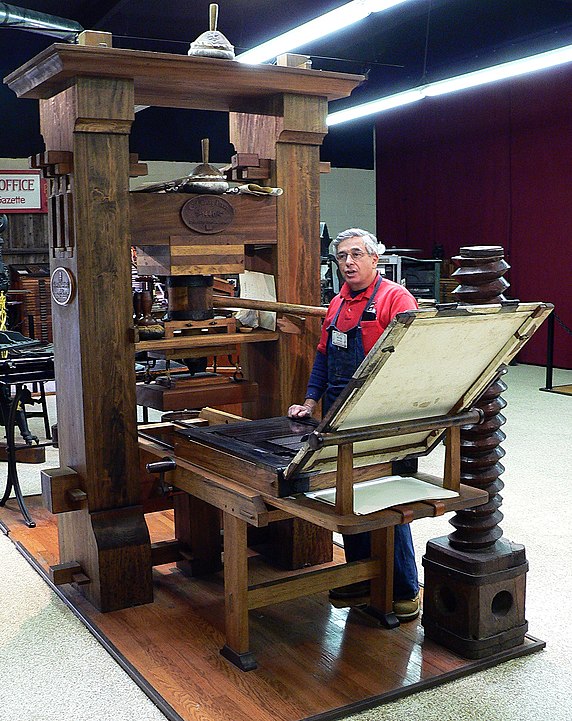
I learned this today. We say “the press” to refer to the media because the first newspapers were made on a movable type printing press.
Johannes Gutenberg invented the movable-type printing press somewhere between 1440 and 1450. By 1450, it was in operation. Before his invention, printing was done using wooden blocks. The page to be printed, text or images, would be carved into the block. Ink would be applied and then it would be pressed onto the paper. This system obviously works, but it takes a long time. If you want to print a 200-page book, you have to carve 200 blocks. You would not be able to use it for regular publications like a newspaper.
Gutenberg took a screw press that was used for pressing grapes to make wine or olives to make olive oil. He adapted the machine so that it pressed more evenly. He added a movable lower table where the paper could be placed and quickly changed.
The idea of moveable-type had been around before, in China and Korea, but it was not widely accepted or used. Gutenberg was trained as a goldsmith, and he used that knowledge to make clear metal letters out of a lead-based alloy. He made a mold that allowed him to mass-produce the letters. The Latin alphabet gave him an advantage over Chinese and Korean because he only had to make sets of 24 letters. Chinese needs thousands.
The required letters would be placed in a wooden frame that was attached to the machine. The paper would be placed on the lower table and swung into place. The paper was damp because that made the ink soak in. The letters in the frame would be inked and the frame would be pressed down onto the paper with the machine. The paper would be removed, and the next paper inserted. Multiple pages of a book could be done at once and printing became much faster.
Johannes Gutenberg revolutionized the print industry, but he couldn’t have done it without some other changes that came along at the same time. It had become possible to mass-produce paper. Handmade paper takes a long time. Without mass-produced paper, a faster printing press would have been no use. It also coincided with the invention of reading glasses, an increase in education, developments in ink, the invention of the codex, a rising middle class, and a sense of entrepreneurship.
After his invention, the number of printed books skyrocketed. By 1500, about 20 million copies of books had been printed. It caused a huge jump in literacy rates and the sharing of knowledge. It could be argued that the printing press is the most important invention ever.
The first newspapers were more like newsletters. In China, in 202 BC, palace reports or imperial bulletins would be distributed by the government. If these were important, they would be posted in a public place for people to read. In Rome, in 59 BC, daily news sheets that had political news or military campaign news were produced. These were called Acta diurnal and were also posted in public places or read from scrolls by town criers. In the Middle Ages, important families would continue this practice, but these were all not really newspapers because they couldn’t be mass-produced.
By the late 15th century, Gutenberg’s printing press had spread all over Europe. It was now possible to quickly print and mass-produce news. In Germany, in the early 16th century, newsletters became more common. They were dated, printed, appeared at regular intervals, and had a variety of news items. The first real newspaper was the Relation of Strasbourg printed by Johann Carolus in 1609.
At first, “press” was used to refer to the machine for printing: the printing press. By the 1570s, the expression was being used to refer to publishing houses. “Freedom of the press” was used in 1680, but it referred to anything produced on a printing press. Between 1800 and 1820, the “press” started to be used for periodical publishing, newspapers, and journalism. By 1921, “the press” had moved to mean only journalists and the media.
Modern newspapers are printed using offset type. This is where an image is etched onto an aluminum plate. This plate then transfers that image to a rubber blanket, which is wrapped around a roll and prints the image onto the paper. Multiple pages can be printed at once and a modern printing press can print 70,000 newspaper pages an hour. It is not really a “press” anymore, but the word “press” has stuck.
So, the printing press with moveable type was invented in about 1450 by Johannes Gutenberg. It revolutionized the publishing industry and also made newspapers possible. The first newspaper was printed in Germany in 1609. At that time, the expression “the press” was used to refer to anything printed on a printing press. By 1820, the term was being used to refer to newspapers and things printed periodically. By 1921, the expression “the press” was being used exclusively to refer to journalists and the media. Modern newspapers are not made on a press, but we still use the expression. And this is what I learned today.
Sources
https://en.wikipedia.org/wiki/Newspaper
https://en.wikipedia.org/wiki/Johannes_Gutenberg
https://en.wikipedia.org/wiki/Printing_press
https://en.wikipedia.org/wiki/History_of_newspaper_publishing
https://en.wikipedia.org/wiki/Newspaper_production_process
https://people.howstuffworks.com/newspaper5.htm
https://www.printingforless.com/Digital-Printing-Explained.html
https://www.britannica.com/topic/publishing/The-age-of-early-printing-1450-1550
https://www.britannica.com/topic/publishing/The-first-newspapers
